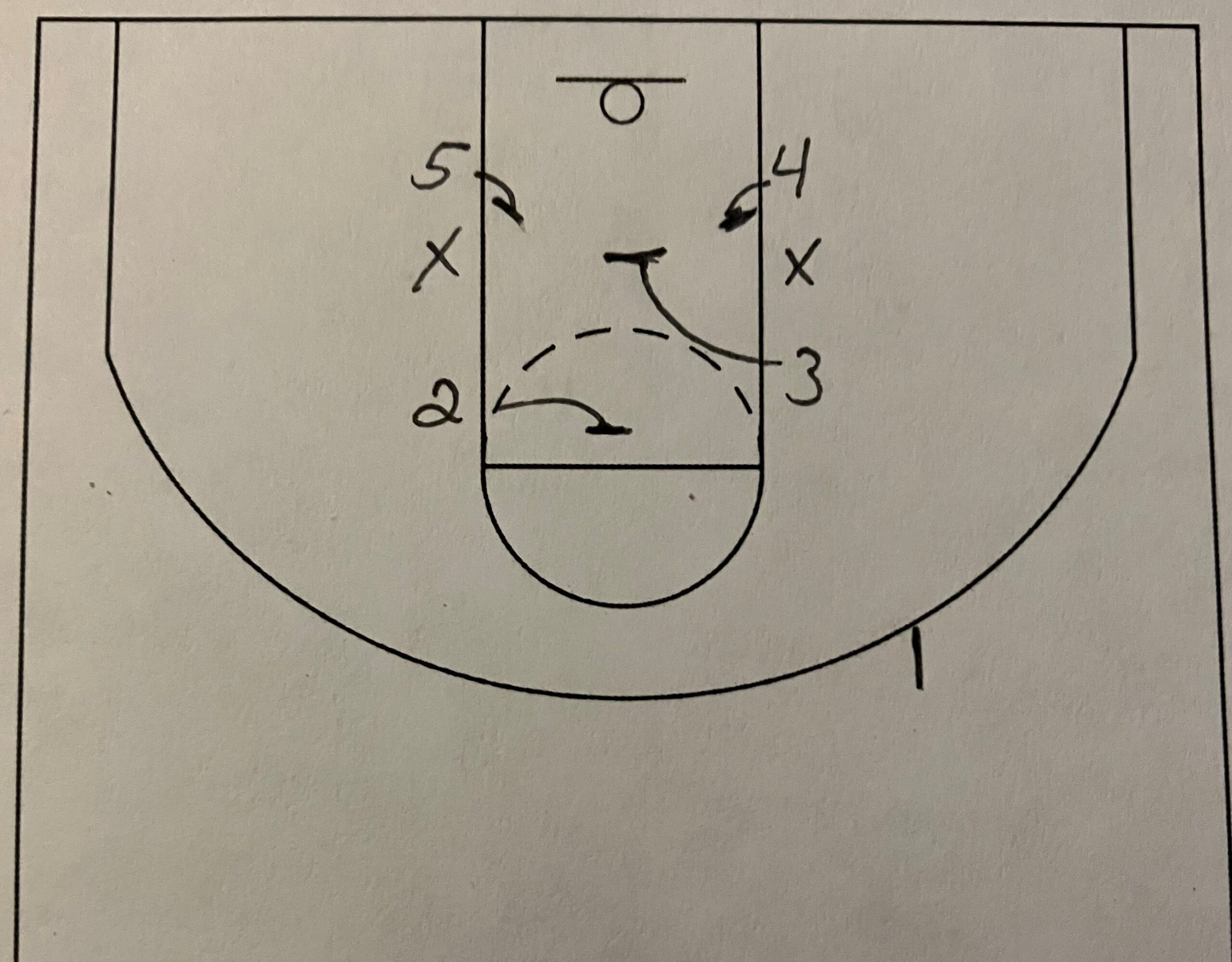Free throw rebounding is one of those things that usually go unnoticed until it becomes a problem. An offensive rebound on a free throw late in the game can change the outcome of a game quicker than just about anything else. Are you practicing free throw rebounding? Do you have a rebounding procedure for the players to follow?
I use the follow rules for all free throw rebounding. We go over it at the beginning of the year and it does not change. The places are set by positions. Each position has a responsibility each and every defensive free throw. Since everything is set, I know exactly what each player should be doing. If they are not doing their job, then it is easy for me to pick out the problem areas and fix them.
Initial Setup
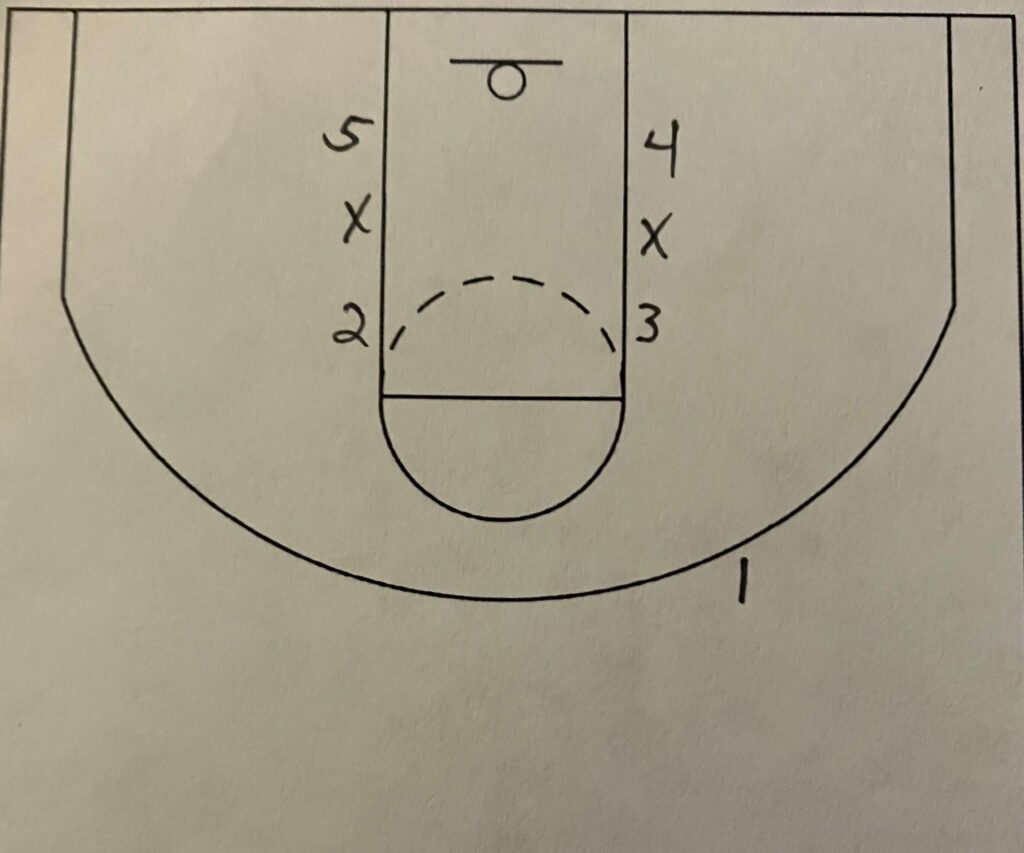
1-Point
The point guard is the one player out of the lane on the setup. They are on the right side of the shooter. If I have to communicate with the team, then I talk to the point guard and they relay the message to the other 4 players.
2-Guard
The guard or 2-man is set on the shooter’s left. They are the 3rd man up the lane.
3-Forward
The forward or 3-man is on the shooter’s right. They are also the 3rd man up the lane.
4-Big
They are on the shooter’s right down on the block.
5-Center
They are on the shooter’s left down on the block.
This is the setup every single time. The positions are not just random. The players do not just get setup in the spots they get to first. I want the players in a spot that works best for not only the free throw but also the rebound and transition.
On the Shot and Rebound
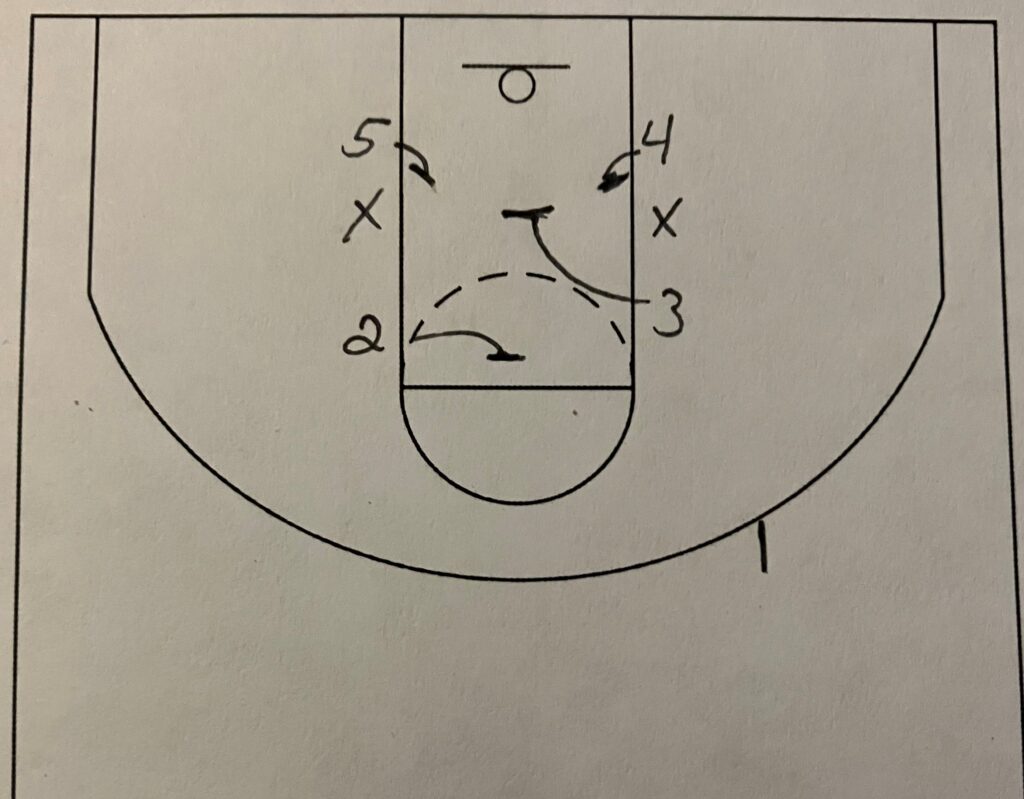
1-Point
The point is standing in his spot waiting for the ball to hit the rim before moving. They have their toes on the 3-point line ready for the rebound or made free throw.
2-Guard
The guard is stepping into the lane and boxing out the shooter. The guard is responsible for boxing out the shooter every single time.
3-Forward
The forward is stepping down into the middle of the lane. The forward is usually a better rebounder than the guard for most teams so I want the forward in a better rebounding position. Any rebound coming off the front should be rebounded by the forward. Depending on how good of a rebounder the forward is, they have the chance to get a bunch of missed free throws in this spot.
4-Big
The big is boxing out the offensive player next to them. They are on their own because the forward is stepping into the middle. However, if the offensive player moves to the middle than the forward has the chance to help make contact and keep them away from the basket.
5-Center
The center is on an island. This is normally the biggest player on the team and normally the best rebounder on the team. They are boxing out the offensive player next to them. Since the guard is moving to the shooter, there is nobody else around this offensive player.
When done correctly the guard has the shooter. The center, big and forward form a wall around the basket giving the offense nowhere to go. These 3 players should form a triangle around the basket. It should not matter where the rebound comes off, a defensive player should be there to collect the ball.
This is where the forward can really pad their stats. The big and center are going to be battling with the offensive players leaving the forward by themselves. If they really go after every rebound, then they can release in any direction to get any rebound. A great rebounding forward can prevent any offensive rebound almost by themselves.
On the Make
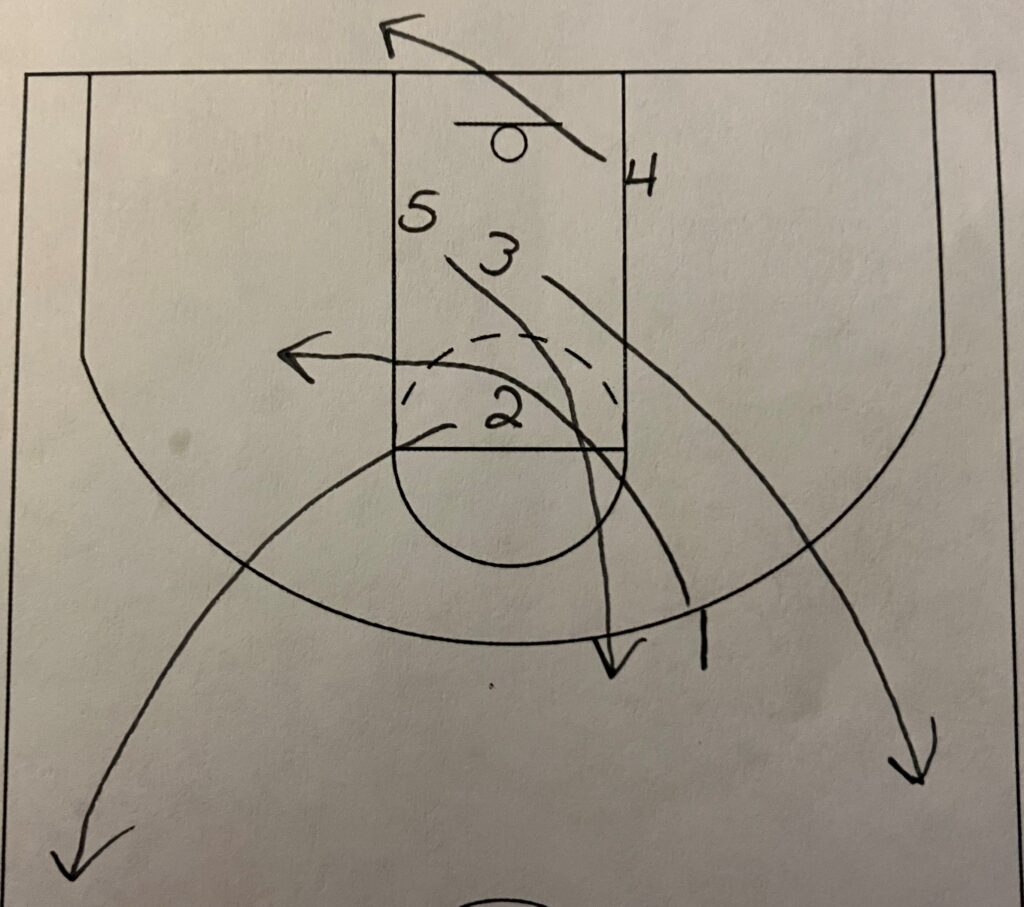
1-Point
The point is running a banana cut going throw the elbow and curling their run back up the floor. Most players are right-handed so having them on the shooter’s right lets them cut across the floor to get the ball into their strong hand going down the floor. This can put the ball in the point’s right hand and potentially make the transition that much faster even on a make.
2-Guard
The guard is going to release where their right hand is on the sideline as they run down the floor. They are boxing out the shooter so they should be able to have a step or two advantage over the other 3 players. With the banana cut by the point, there is a chance for an entry pass after the make and then an advancement pass up the floor to the guard. If the point can pass the ball up the floor to the guard, then the speed of the transition is going to be very fast.
3-Forward
The forward is releasing up the other side of the floor away from the guard. If the point is made to change directions and go across the floor, then the forward should have enough time to get back in front of the point. If the point can catch and go, then it is going to be hard for the forward to get out in front because they are having to go back to the basket for the rebound.
4-Big
The big is grabbing the ball and moving in the same direction as the point as they get out of bounds. The big should clear the edge of the backboard when getting out of bounds. If the guard is open running down the sideline, then the big can make a long pass straight to the guard somewhere around half-court. If the long pass is not there, then the big is passing the ball into the point as the point is cutting through the lane.
5-Center
The center is releasing straight up the middle of floor. Depending on what the team is doing in their transition, the center can release anywhere going up the floor.
Transition Lanes
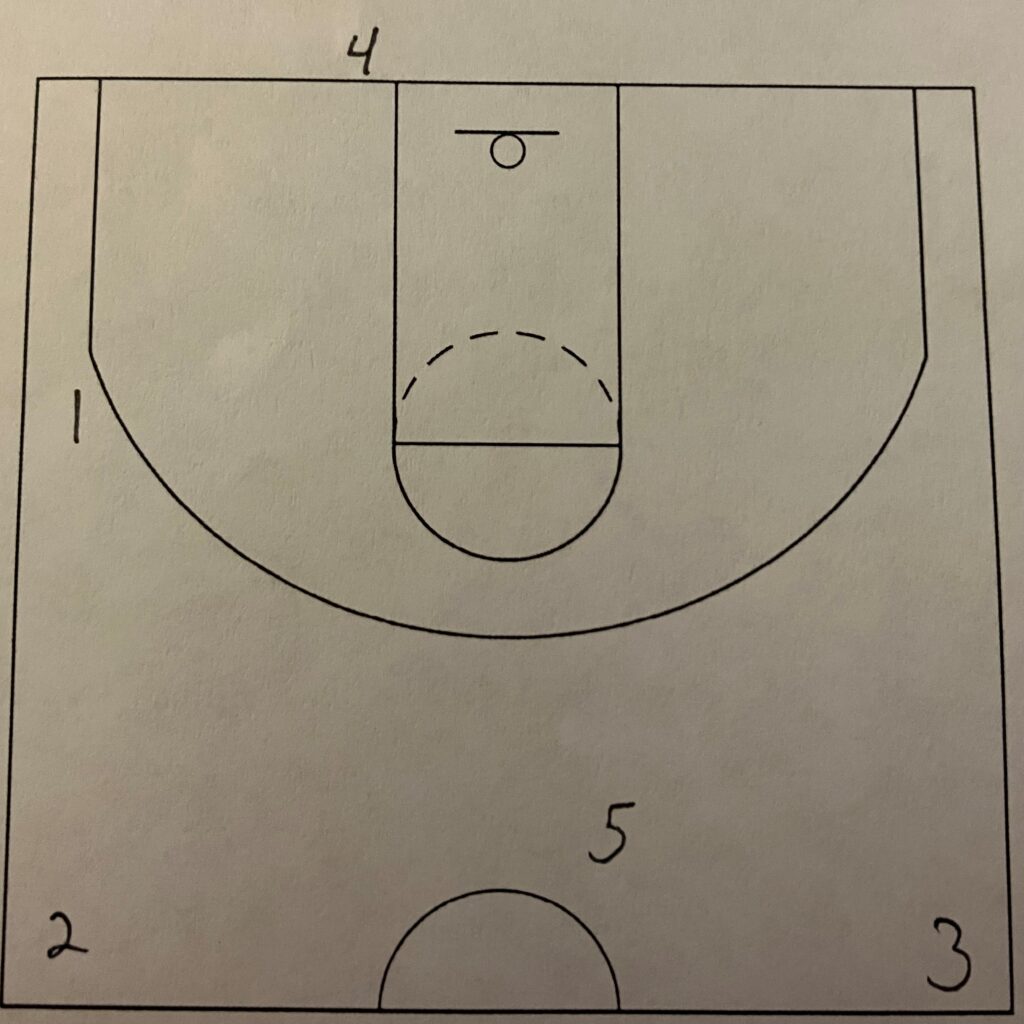
1-Point
Once everybody clears, each player has a certain spot on the floor for transition. The point is catching the ball on the right side of the floor and attacking the open floor.
2-Guard
The guard is running up the right side of the floor. The guard is the first option for the point to throw a pass up the floor. If the point is able to pass the ball up to the guard, then the guard has the chance to attack the basket before the defense gets back.
3-Forward
The forward is running up the left side of the floor. If the point crosses the midline of the floor, then the forward is up the floor on the sideline for an advancement pass. The guard and forward are on opposite sides of the floor. If either can get a pass from the point early in transition, then they can attack with the ability of kicking the ball out to the backside to the other player.
A team with a good guard and forward is able to advance the ball and attack the basket with the bonus of having that kick out 3 to the backside of the defense. The defense will normally run to the frontside of the transition leaving the backside wide open. A good guard/forward combo can give a team a bunch of wide open 3’s.
4-Big
The big is taking the ball out to start transition and staying in the trail position. They are the back pass if the point gets in trouble with the ball during transition.
5-Center
The center runs down the middle of the floor to one of the blocks. I like the center running to the ball side block for a possible early post entry. However, the center can run to the backside block to open more space for the point or guard or forward to attack the basket in the open court during the transition.
Conclusion
By setting down rules for each player and spots for each player to run too, every player understands what is happening. This gives the players the knowledge of where to look for the next pass if they get in trouble. By having these rules in place, the number of turnovers in transition has greatly reduced for me. The players know where their teammates are at and know where the ball needs to go for the best possible chance to score early in transition.
The biggest positive is late in games when we are losing. The players are having to try and go faster which can lead to turnovers. Since we have these rules in place, we do not have to change anything to gain the opportunity to score quickly. Scoring quickly comes down to making earlier passes and attacking as soon as possible. The rules and spots are still all the same. This has helped my teams have a calmness late in games and not panic when we are losing and having to foul. It has helped my teams execute at a high level late in games when games can be the most chaotic.

